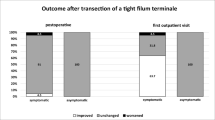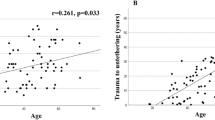Abstract
Background
Although terminal syringomyelia suggests a tethered spinal cord, a consensus has still not been established for surgical indications, when there are no associated abnormalities or only minor associated abnormalities. We analyzed surgical outcomes of sectioning a filum terminale in patients with terminal syringomyelia to elucidate the significance of untethering surgery.
Methods
Fifty-seven pediatric patients with terminal syringomyelia who underwent untethering via sectioning the filum terminale between 2007 and 2018 were retrospectively analyzed. Postoperative outcomes of symptoms and MRI findings were evaluated.
Results
Of 57 patients, 40 had other associated abnormalities (25 with filar lipoma and 29 with low conus medullaris) that could be responsible for tethered cord. Nineteen patients had symptoms. The mean age at the time of surgery was 18 months (3–96 months). The mean follow-up period was 3.3 years (1–9 years). Preoperative symptoms improved in 9 patients (47%) after surgery. At 1 year after the surgery, the size of syringomyelia decreased in 19 (33%), increased in 4 (8%), and did not change in 34 (69%) patients. Of 28 patients who were followed up for more than 3 years, the size decreased in 17 (61%), increased in 1 (4%), and did not change in 10 (35%).
Conclusion
When untethering was performed by sectioning a filum terminale, the size of terminal syringomyelia decreased in more than half of patients in the long term. Sectioning the filum terminale demonstrated the possibility of radiological and clinical improvement in patients with terminal syringomyelia.

Similar content being viewed by others
References
Batzdorf U (2000) Primary spinal syringomyelia: a personal perspective. Neurosurg Focus 8:3E7
Blegvad C, Grotenhuis JA, Juhler M (2014) Syringomyelia: a practical, clinical concept for classification. Acta Neurochir 156(11):2127–2138
Coleman LT, Zimmerman RA, Rorke LB (1995) Ventriculus terminalis of the conus medullaris: MR findings in children. AJNR Am J Neuroradiol 16:1421–1426
du Boulay G, Shah SH, Currie JC, Logue V (1974) The mechanism of hydromyelia in Chiari type 1 malformations. Br J Radiol 47:579–587
Gardner WJ, Angel J (1958) The cause of syringomyelia and its surgical treatment. Cleve Clin Q 25:4–8
Klekamp J (2002) The pathophysiology of syringomyelia—historical overview and current concept. Acta Neurochir 144:649–664
Koyanagi I, Houkin K (2010) Pathogenesis of syringomyelia associated with Chiari type 1 malformation: review of evidences and proposal of a new hypothesis. Neurosurg Rev 33:271–284 discussion 284–275
Kulwin CG, Patel NB, Ackerman LL, Smith JL, Boaz JC, Fulkerson DH (2013) Radiographic and clinical outcome of syringomyelia in patients treated for tethered cord syndrome without other significant imaging abnormalities. J Neurosurg Pediatr 11(3):307–312
Levine DN (2004) The pathogenesis of syringomyelia associated with lesions at the foramen magnum: a critical review of existing theories and proposal of a new hypothesis. J Neurol Sci 220:3–21
Magge SN, Smyth MD, Governale LS et al (2011) Idiopathic syrinx in the pediatric population: a combined center experience clinical article. J Neurosurg Pediatr 7:30–36
Author information
Authors and Affiliations
Corresponding author
Ethics declarations
After the study was approved by the institutional review board, we conducted a retrospective review of all patients with terminal syringomyelia who underwent untethering via sectioning of the filum terminale at the National Center for Child Health and Development between January 2007 and June 2018.
Conflict of interest
The authors declare that they have no conflict of interest.
Additional information
Publisher’s note
Springer Nature remains neutral with regard to jurisdictional claims in published maps and institutional affiliations.
Rights and permissions
About this article
Cite this article
Ishisaka, E., Usami, K. & Ogiwara, H. Surgical outcomes by sectioning a filum terminale in patients with terminal syringomyelia. Childs Nerv Syst 36, 3035–3039 (2020). https://doi.org/10.1007/s00381-020-04615-5
Received:
Accepted:
Published:
Issue Date:
DOI: https://doi.org/10.1007/s00381-020-04615-5




